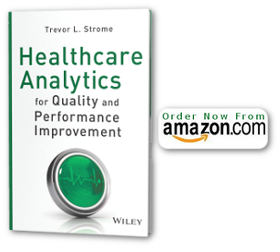I read an excellent article in Information Management entitled “Having Analytics May Not Be Enough”, by Soumendra Mohanty. Although the article is not specifically about analytics in healthcare, the author does make some relevant points for those who use analytics in the field of healthcare.
To gain (or maintain) a competitive advantage, businesses have been heavily investing in technology infrastructure for data warehousing and comprehensive business intelligence (BI) reporting and analysis capabilities. This investment is an effort to improve decision-making – that is, to make better and more timely decisions to improve business performance.
HCOs need to make better decisions faster
Healthcare Organizations (HCOs) are no different in their need for making better and faster decisions. After all, healthcare organizations are facing increasing financial, quality, and legislative pressures. HCOs to are turning to business intelligence and analytics tools for management and strategic reporting and, perhaps more importantly, to provide insight for teams involved in healthcare quality and process improvement.
As Mohanty points out in the article, the presence of a well-established business intelligence infrastructure and the capability to dive deep into data does not guarantee that that the information derived from these systems is “used pervasively or in a timely fashion” (or, for that matter, at all).
Most BI and analytics implementations are still retrospective
Mohanty states that there is a critical difference between simply examining historical data and reporting on previous organizational performance, versus providing “predictive capabilities that support proactive decisions.” The issue with most standard BI implementations is they can only tell you what has happened.
For example, during an influenza outbreak, it is one thing to know how many cases of influenza presented to an already crowded Emergency Department last week; it is entirely different (and much more valuable) to predict, with reasonable accuracy, how many will show up tomorrow and over the next couple of days.
The analytics “gap”
Soumendra suggests the presence of an analytics “gap”. A leap in capability will need to occur to move from standard BI/analytics activities (such analyzing past performance, reviewing historical reports, and making reactive decisions) to identifying patterns and making proactive decisions. This advanced capability will rely on deep data analysis, modeling, simulation, and forecasting. Unfortunately, these capabilities are currently beyond the core competencies of most HCOs; the skills required still typically reside in the realm of very specialized clinical and informatics experts (such as researchers).
Predictive analytics to meet future healthcare demands
Many healthcare organizations have developed impressive business intelligence infrastructures that are used in daily decision-making. Making decisions in complex environments (such as healthcare) based on purely retrospective data, however, can still leave HCOs “behind the curve”.
As the analytic capabilities of HCOs expand to become more predictive, the resultant proactive decision making will enable HCOs to better meet the growing challenges facing healthcare as the needs of patients and the demands of legislation continue to stress the healthcare system.

{ 0 comments… add one now }
{ 1 trackback }